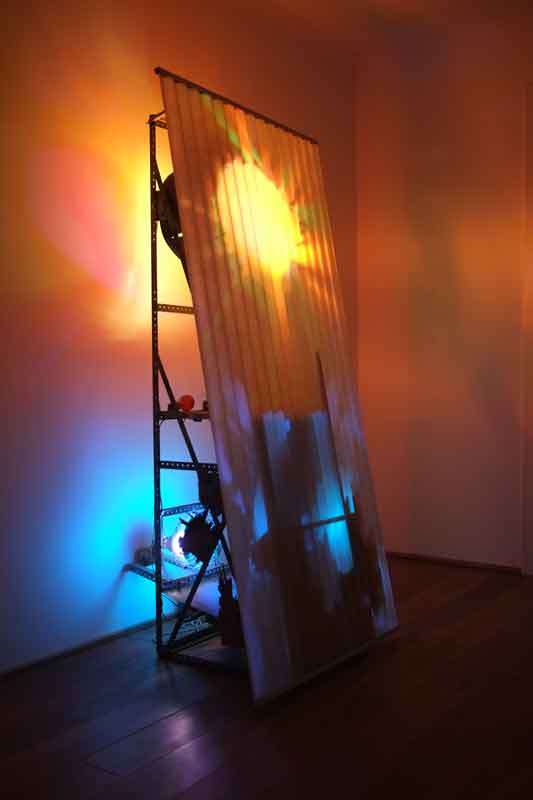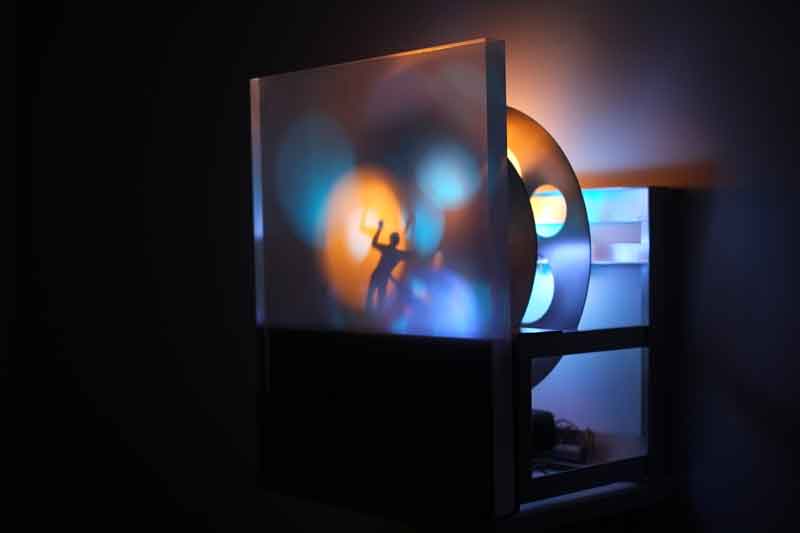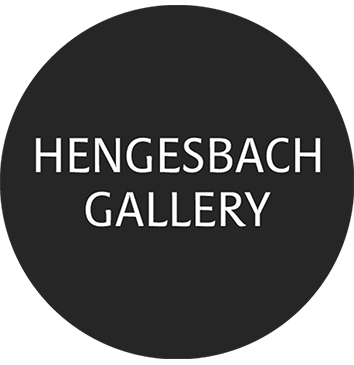Jon Kessler & Viktor Kopp
December 4, 2018 – January 25, 2019
What a completely novel experience it must have been—to no longer access the world through our own observation or through collections of individual images, but instead to encounter the world on a flat screen, via what was once called the “flicker box.” Solid, materialized images became colored points of electric light, constantly shifting. Though intangible themselves, these lights paradoxically claimed to open up entirely new frameworks of meaning for us.
Both the sculptural work of Jon Kessler (New York) and the pictorial works of Viktor Kopp (Stockholm) reflect artistically on the advent of the flicker box—how it shapes new content for us and brings about a fundamental transformation in our cultural understanding of the world. On one hand, the flicker box claims the authority to report on everything; on the other, it imposes specific patterns on us—dictating the sequence of images, the constant jumping between points of view and locations. It changes our perception of time, our attention span, and our sense of connection with our immediate surroundings.
Jon Kessler picks up on the essential element of the flicker box by making light the central medium of his artistic work. But in his hands, light is not merely a means to an end—it is explored and rendered in terms of its aesthetic value. At the same time, he reveals it as the primal event of human creation. A recurring focal point of Kessler’s work is the ever-changing visual staging of Plato’s Allegory of the Cave: we are bound in a cave and perceive the world only as the reflection of a fire behind us, which casts shadows of all external events onto the cave wall.
This allegory is also the original myth of image creation—for the three-dimensional, moving world must be translated onto a flat surface. This primal myth has echoed throughout Western art history. Kessler renders it graspable in radical form: in his work, color and light intensity shift, and movement elements are introduced—the cave comes alive. Yet it doesn’t transform into a Broadway musical or a Hollywood production; it remains elemental. The light shifts and movements are comprehensible. The medium is illusion—but an illusion that is transparent, relying on mechanical components and simple electrical circuits rather than synthetic digital illusions.
It is no surprise that as early as 1983, the very year he fully established his sculptural practice, Kessler took on the representation of a primal human myth: a horde of wild figures, dancing and waving self-made weapons, celebrating the dawn of a new age.
Another myth he addresses is that of the heroic athlete, defying gravity with outstretched limbs. A third is the myth of maintaining decency and fairness in social conflict. Here, Kessler draws on figures from the first *Robin Hood* film, highlighting its distinct cultural realms—forest, city, monastery—to stage justice as a daring confrontation between different moral characters. Against this foreground layer, Kessler sets an image of Indian salvific life—as a fate-accepting, figurative floating—in a shadowy background realm. These model scenarios of our culture appear as shimmering, shifting light behind projection screens: a corrugated fiberglass sheet, a thick acrylic glass plate, or a pane of marbled stained glass. The cave’s projection wall enters Kessler’s contemporary image world in a magical, fairy-tale manner—appearing as a bizarre, self-staging procession.
Viktor Kopp’s paintings, too, are projection screens—but they employ the color and light-interweaving possibilities of oil painting. A direct transformation of the flicker box’s light play is not at the center of his work. Instead, Kopp draws more heavily from two sources: from the media prehistory of universal light narration—especially in the storytelling modes of the comic—and from the pictorial turning points found in Magritte’s image concepts from the late 1920s.
Comics reduce three-dimensional reality to sign-like forms, using curved lines, open or closed contours, and filled areas to suggest movement and energy. In soft transitions between glazed and impasto oil paint, Kopp’s *Spaces between Lovers* bring together fragments of our dreams—of a warmer, more cheerful world—into an absurd conversation with our fears of a dark, dungeon-like or prison-like existence. The kitschy sunset becomes the connecting thread.
In *Journey to the Center of the Earth*, four triangular landscape segments are merged into an oval total segment surrounded by white light—like in a slide projector—so that orange, red, green, and brown fuse into a shimmering conspiracy of color.
Finally, in *The Hunter*, the world is turned upside down. As in the final scene of Kubrick’s film *Dr. Strangelove or: How I Learned to Stop Worrying and Love the Bomb*, hats sail toward a potential end of the world—into a final, skyward shooting of apocalyptic absurdity.
Installation Views

JON KESSLER, The Guiding Light, 1983, Mixed media with lights and motors, 214 x 102 x 95 cm

JON KESSLER, The Fall, 1985, Mixed media with lights and motors, 64 x 51 x 40 cm

VIKTOR KOPP, Spaces Between Lovers, 2005, Oil on canvas, 200 x 267 cm
